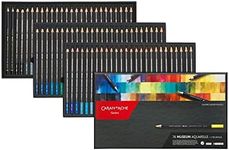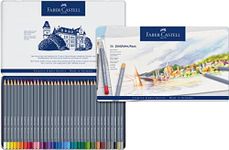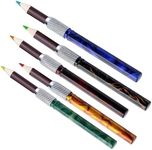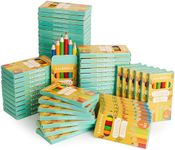Buying Guide for the Best Watercolor Pencils
Choosing the right watercolor pencils can make a big difference in your art experience, whether you’re a beginner or a more experienced artist. Watercolor pencils are unique because they can be used dry like regular colored pencils or with water to create beautiful, paint-like effects. When shopping for watercolor pencils, it’s important to consider a few key features that will affect how they perform and how enjoyable they are to use. Understanding these features will help you pick a set that matches your artistic style and needs.Pigment QualityPigment quality refers to how rich and vibrant the colors are when you use the pencils, both dry and with water. High-quality pigments produce more intense and long-lasting colors, while lower-quality pigments may look dull or fade over time. If you want your artwork to have bright, bold colors or to last for years, look for pencils that mention high pigment content or artist-grade quality. For casual sketching or practice, student-grade pencils with moderate pigment may be enough.
SolubilitySolubility is how easily the pencil marks dissolve and blend when you add water. Some pencils dissolve almost completely, leaving no pencil lines, while others leave a bit of texture or grain. If you prefer smooth, paint-like washes, look for pencils known for high solubility. If you like to see some pencil texture in your work, a pencil with lower solubility might suit you better. Think about the effects you want to achieve in your art to guide your choice.
LightfastnessLightfastness is a measure of how well the colors resist fading when exposed to light over time. If you plan to display your artwork or sell it, choosing pencils with high lightfastness is important to keep your colors looking fresh. If you’re just practicing or making art for fun, this may be less important. Lightfastness ratings are often listed on the packaging or in product descriptions.
Core HardnessCore hardness describes how soft or hard the pencil lead is. Softer cores lay down color more easily and are better for blending, but they wear down faster and may break more easily. Harder cores are good for detailed work and last longer, but they may not blend as smoothly. If you like to do detailed line work, a harder core might be best. If you prefer bold, expressive strokes and lots of blending, a softer core could be a better fit.
Color RangeColor range is the number of different colors included in a set. Smaller sets are more portable and easier to manage, but larger sets offer more variety and flexibility for mixing and shading. If you’re just starting out, a basic set with essential colors is usually enough. If you like to experiment with lots of shades or do complex pieces, a larger set might be more satisfying.
Pencil Barrel DesignThe design of the pencil barrel affects comfort and ease of use. Some pencils have round barrels, while others are hexagonal or triangular to prevent rolling and improve grip. The thickness of the barrel can also make a difference, especially if you have smaller or larger hands. Try to choose a design that feels comfortable for you to hold during longer drawing sessions.















![Sanford Prismacolor Watercolor Pencil Set, 24-Pack [Misc.]](https://images-proxy.bestreviews.guide/oOJFlMM63eNHlnCg0QyyinpbDmo=/0x150/https://m.media-amazon.com/images/I/51dyD-Ybb9L._AC_CX679_.jpg)